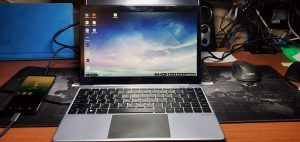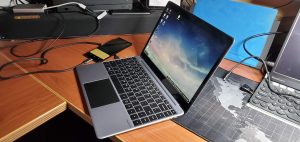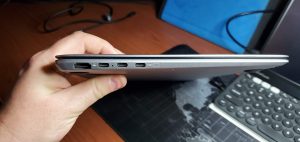

Update 02/17/2020: Nexdock has updated their design to include a touch panel as the current model is non-touch.
This is the NexDock 2. It is basically a laptop shell that requires some other source of intelligence to power it. We have tested it with a Samsung Galaxy Note 8 and 10, a GPD XD+, a Raspberry Pi and a Nintendo Switch. Each device works quite well, except that the audio controls don’t always work – more on that later.


The build is good for a device of this price range. It has a nice solid feel. I would be comfortable using it as my only device paired with my Note 10 for trips or visits to client sites. It feels well-made and doesn’t make me nervous that it will break. It has an HDMI input and three USB-C ports on the left. There is one USB-A port, audio output and a Micro-SD slot on the right. If you are wondering why there are three USB-C ports on the left, the one closest to the HDMI input is for power. The next one is for certain connectivity, like a Raspberry Pi or other devices that have USB-OTG. The last one is for phones. The NexDock 2 also has 4 speakers under the keyboard and a large 51 Watt-hour (7.6 V, 6,800 mAh) that it uses to power itself as well as power or charge the connected device. My experience shows it can go 5 or 6 hours depending on the device. My Note 10 will usually last longer than a Raspberry Pi because of my Note 10 battery.
My only major complaint is that there is quite a bit of light bleed along all edges of the screen. In most normal use, I don’t notice it, but when watching videos or using something with a dark background, it can be annoying. Other than that, it doesn’t appear to cause any other issue.

Recent Samsung devices all include “Dex” mode. It’s their desktop experience and it is getting better with time. I can make Dex work for me for a lot of what we do, which is why having the NexDock 2 paired with it is pretty cool! It also works well with a Raspberry Pi – plug it in to the HDMI input and the micro-USB adapter (Pi 2 or 3) or USB-C (Pi 4) cable and it starts up and can run off the internal NexDock 2 battery.
For most use cases, the audio is fine and works well. When a compatible device is plugged into the correct USB-C port, the volume controls work. However, when I plugged in a GPD XD+ android based game console, the volume was either off or full blast. This also means that any device that you plug into the HDMI port may suffer the same fate. Some devices will let you control their volume manually on the device though. The XD+ is not one of them. The XD+ also does not support USB-OTG, which might allow the volume keys to work. When I asked NexDock about it, they said that it would have cost too much to redesign to use physical volume keys or to connect the keyboard power internally. That makes sense and perhaps this will be rectified in the NexDock 3!

All-in-all, I love the concept and generally like the way NexDock 2 accomplishes it. The speakers don’t get super loud, but that doesn’t bother me too much since I usually have Bluetooth ear buds in. The keyboard feels nice and the track-pad has been one of the better small-company designs.
Verdict: 7 out of 10.
Who is this for: People that have their life on their phones and don’t want another device.
Price: $249 + Shipping
How do I get one: NexDock